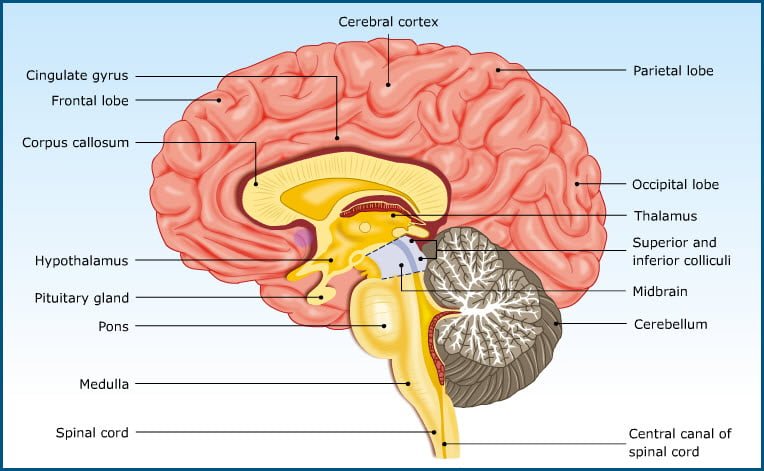TABLE OF CONTENTS
Physiological Functions of Cerebral Cortex
Physiological functions of cerebral cortex is to provides necessary neural connections and orders to skeletal muscles required for proper response based on emotion.
Cerebral Cortex
The cerebral cortex provides the necessary neural connections and commands to skeletal muscles, enabling a proper response based on emotions.
As a ganglionic blanket covering the brain, it has an unparalleled structural function, with millions of nerve fibers originating from it.
The cerebral hemisphere is the predominant portion of the brain .
Each cerebral hemisphere is composed of a covering of grey matter [cortex or pallium], a cerebral mass of white matter and the basal ganglia [mass of grey matter.
The cortex is the highest integration centre in the somatic nervous system to regulate complex skeletal muscular movement and its functions are under voluntary control.

Cerebral cortex acts as a centre for consciousness, and storages of experience. The bilaterally situated cerebral cortex of telencephalon is divided into a primary olfactory portion called the allocortex and a non olfactory portion called the neocortex, in mammals the allocortex is often called as the limbic system.
Isocortex
The isocortex is the outer layer that integrates and interprets sensory information to initiate voluntary movements. It has outer folds, known as gyri, and grooves, called sulci, which increase its surface area.
An increase in surface area leads to a higher number of neurons, and their interconnections enhance functional complexity. In other vertebrates, such as reptiles, birds, and amphibians, the neocortex is either absent or poorly developed.
The allocortex regulates emotions. The cortex has a distinct cellular architecture and is divided into six layers.
Physiological Functions of Cerebral Cortex
- Centre for voluntary movements – Exerted by the primary motor cortex, specifically the excitomotor cortex, which is also responsible for highly skilled movements.
- Centre for quick and phasic movements
- Centre for postural maintenance – Controlled by the supplementary motor area.
- Centre for stretch and postural maintenance
- Centre for major motor control – Mediated by the pyramidal and extrapyramidal tracts.
- Centre for complex coordinated movements
- Frontal eye field of the cerebral cortex – Concerned with eye movement, pupillary dilation, and tear secretion.
- Centre for reflex vocalization
- Centre for learning, memory processing, and memory storage – Compares past experiences and interprets present experiences.
- Centre for mood, emotions, and behavior – Regulates functions like socialization.
- Centre for receiving specific sensations – Crude sensations have subcortical destinations (except for pain and crude temperature perceptions, which are processed at the thalamus level). Finer sensations of touch, temperature, joint position, and vibratory senses are relayed to the cortex.
- Centre for discriminative ability
- Centre for spatial recognition
- Centre for tactile discrimination and localization
- Centre for comparing and recognizing the relative intensity of different stimuli
- Centre for recognizing similarities and differences (stereognosis)
- Centre for gustation – Located at the lower end of the somesthetic cortex, adjacent to the motor cortex governing the muscles of mastication.
- Centre for visual senses and visuo-psychic sensations
- Centre for auditory senses and audito-psychic sensations
- Centre for olfactory sensations